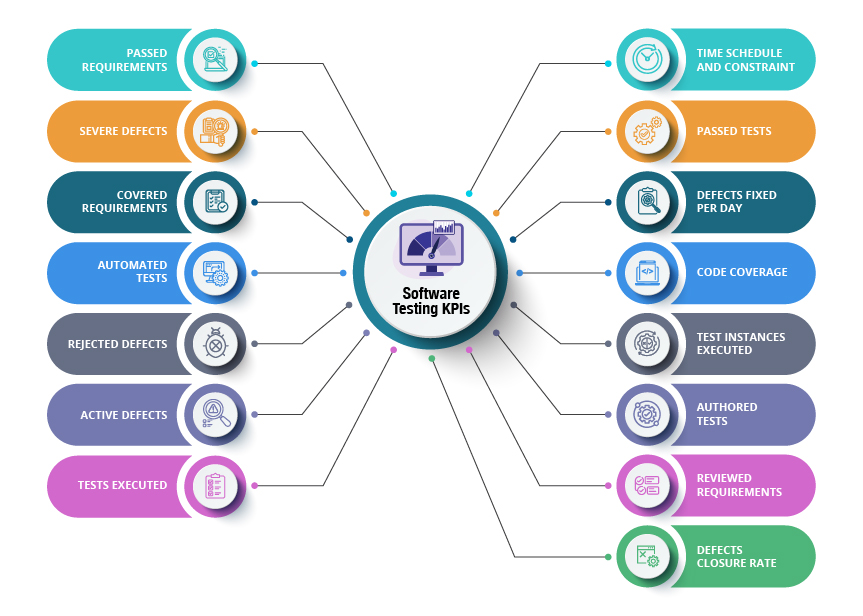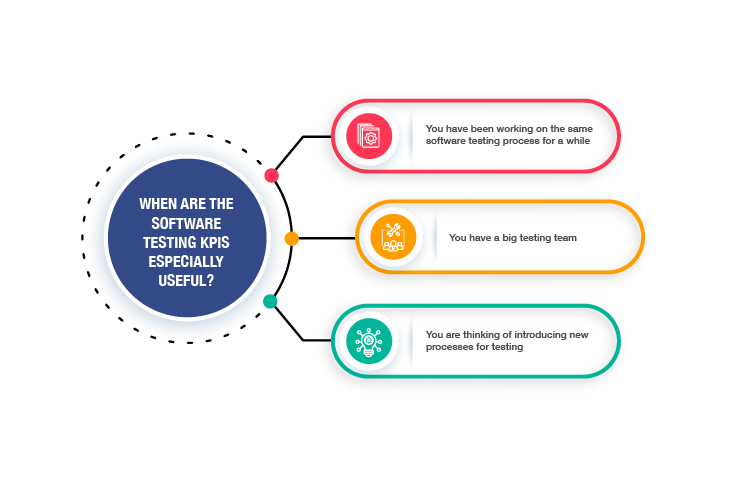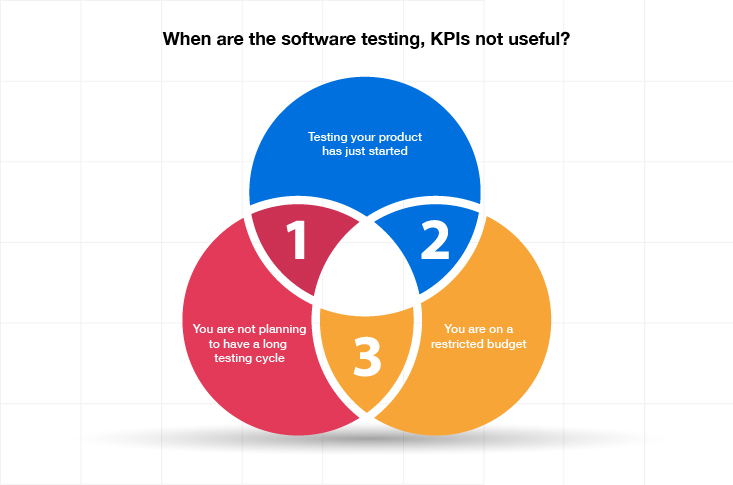Software KPIs or Key Performance Indicators in the software testing industry are some measurable values computed to gauge the efficiency and effectiveness of the software testing process as a whole.
Though it may seem natural to use software testing KPIs to gauge efficiency, there is a divide between the people of the testing community on using KPIs in the Software Testing industry. Some say that Software Testing KPIs can’t help achieve a much-needed balance between time, cost, and quality, while others swear by their effectiveness.
Organizations have different products, so the development methodology and the testing processes are different too.
So what a QA individual or manager needs is to:
1. Understand the process
2. Review the KPIs that can be measured
3. Figure out the KPIs for quality that should be measured for maximum effectiveness according to your project.
Table Of Contents
What Are the Kpis in Software Testing?
There is no hard and fast rule to measure all these KPIs and you can also come up with KPIs that are not mentioned in the list. The most common KPIs that are measured in the software testing industry:
This KPI measures the percentage of test cases automated against the total number of test cases. Usually, a higher percentage means a better probability of catching any breaks during automation runs. The threshold for the percentage of automation should be decided according to the type of product and cost of automation.
This KPI is used to measure the mapping of test cases to requirements. A test manager is required to ensure that all the requirements have corresponding test cases, and action should be taken on any requirements that could not be mapped to any test case and vice versa. The goal is to keep the mapping of requirements to test cases to 100%.
This KPI is used by testers to ascertain the percentage of code they cover with their automated tests.
This is used to measure the effectiveness of the development but is subjective as some bugs could be more challenging to fix than others. This could be used to predict the amount of work for the testing team.
This KPI becomes valid when the release of a product is being planned. If any requirement has yet to pass testing, the release should be delayed.
To understand the effectiveness of the test case design process, the number of defects reported via designed test cases is measured, where test cases passed means the design is practical and vice versa.
This KPI measures the percentage of rejected defects compared to the total defects reported. If the percentage is higher than the set threshold value, the underlying issue must be identified and acted upon. This could mean more training for software testers or better requirement documentation.
This KPI is to make sure that any requirement that the testing and development team is working on has been reviewed by the subject matter expert and is good to go. Reviewed requirements could lead to accurate development and testing, proving costly in the long run.
This KPI aims to keep the number of severe defects in an application at a time under a limit if there are more severe defects, then immediate action is needed. But before using this, the testing team needs to be properly trained to identify severe defects correctly.
This KPI is to measure the velocity of test execution at any point in time to make sure that the testing cycle is on track for the release.
This KPI measures the total number of test cases executed on a build, including manual and automated, at any given time. This is also a Velocity KPI. Read here about Velocity Testing.
This KPI is used to measure the average time of test execution. This helps provide testing time estimates during release planning or the development and testing plans to the project managers.
This KPI measures testers’ efficiency in verifying and closing the fixed defects; this also helps to estimate the release cycle better.

When Are the Software Testing Kpis Beneficial?

- You have been working on the same software testing process for a while.
When you have implemented a testing process successfully and have executed it a few times, it is the right time to measure the KPIs to know the areas where your testing process needs improvement.
- You have an extensive testing team.
Having a big testing team also means that there will be an extensive distribution of testing tasks. So to make sure that the tasks are distributed effectively and are conducted efficiently, measuring some testing KPIs will prove beneficial and will also help to keep everyone on track.
- You are thinking of introducing new processes for testing.
If you are revamping your testing process, it will be helpful to have some KPIs measured to the original process. It will help you decide what goals to achieve with the new testing processes.
For an organization looking to measure KPIs, it is essential to understand the existing testing process and then measure the KPIs that will bring out the necessary improvements. Knowing what value addition you are looking for is essential because these KPIs, if not used properly, could easily lead you in the wrong direction.
When is the Software Testing Kpis Not Useful?
Although measuring the effectiveness of a process is essential to know if you are doing it right, measuring the testing process via quality KPIs will not make sense in a scenario where:
- If your product has just started with Testing:If you are going to launch your product for the first time and testing has just started, there won’t be much to measure. This time will be crucial to put a testing process in place rather than measuring the effectiveness of the testing process.
- If you are not planning to have a long testing cycle:If you are making a product that would not be changing for a long time after the launch and testing will be a one-time process, measurement of the effectiveness of the process would not be beneficial as you won’t have any new testing cycles to improve upon.
- If you are on a restricted budget:Just like doing any activity, measuring testing KPIs also takes time and effort and, consequently, costs. So rather than measuring the KPIs, applying a cost-effective testing process should be the primary focus when the budget for testing is restricted.
By ensuring the above, you are also optimizing Testing for Continuous Delivery.
If you have an organization planning to move to test automation but are worried about the learning curve and time constraints during implementing it, look out for tools that enable you to automate test cases in as much time as creating them manually will take. This will help improve multiple KPIs for quality, such as Automated Tests, Covered Requirements, Passed Requirements, Passed Tests, etc.Testsigma is one such tool that is quickly recognized for its ease of use and the negligible learning curve!

Testsigma is one such tool that is quickly getting recognized for the ease of use and the negligible learning curve!
Frequently Asked Questions
How Do You Measure QA Success?
QA success can be measured using KPIs, which will help to get an idea about the test performance. Some key points which are mentioned in KPIs are given below.
- Numbers of functional defects in the software.
- Number of tests written in a time frame.
- Numbers of automated cases present in testing.
- How much code is covered in the test cases?
- How many defects are being fixed per day?
What is Software Testing Key Performance Indicators(kpis)?
Key performance indicators(KPIs) in software testing are the calculated data that help to measure the performance and effectiveness of testing. It gives an idea if the software testing is progressing in the right direction and whether it will be done on time.
What is the Difference between Software Testing Metrics and Kpis?
Software testing metrics are the data used to track and monitor the various operations performed by the testers. Whereas organizations and testers use key performance indicators (KPIs) to determine testing effectiveness and the time and cost required to complete the testing.
What is KPI for the QA Department?
KPI for QA is calculated by : The number of tests in a specific time period = Number of tests run/Total time.
Following initial testing, these periods should reduce and eventually settle at a basic level. QA teams can improve these figures by investigating which tests can be executed concurrently or automatically.










